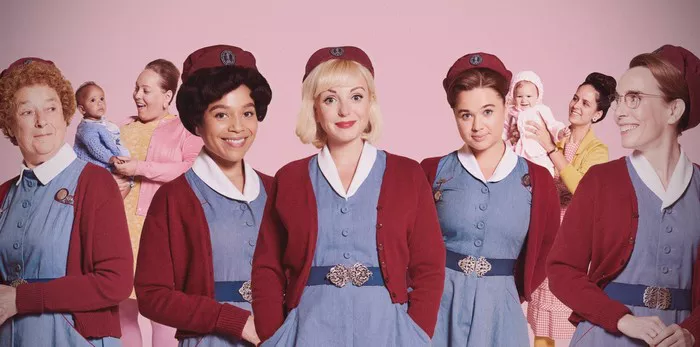In the realm of television drama, few series capture the hearts of audiences quite like “Call the Midwife.” Set in the impoverished Poplar district of London during the 1950s and 1960s, the show follows the lives of a group of dedicated midwives and nuns from Nonnatus House as they navigate the challenges of childbirth, societal change, and personal growth. With its poignant storytelling, rich characters, and historical backdrop, “Call the Midwife” has become a beloved staple of British television since its premiere in 2012. Now, as the series embarks on its latest installment, fans eagerly anticipate what new trials and triumphs await their favorite characters.
The New Series
The new series of “Call the Midwife” continues the tradition of heartfelt storytelling that has endeared the show to audiences worldwide. Created by Heidi Thomas and based on the memoirs of Jennifer Worth, the series has consistently delivered compelling narratives that explore themes of compassion, resilience, and the human experience. As the characters confront the challenges of a rapidly changing world, viewers are drawn into their lives, forming deep connections that transcend time and place.
Setting the Scene: Post-War Poplar
At the heart of “Call the Midwife” lies its evocative portrayal of post-war Poplar. A bustling, working-class district in the East End of London, Poplar serves as the backdrop for the trials and triumphs of the midwives and nuns of Nonnatus House. From its cobbled streets to its cramped tenements, the show’s attention to detail brings this vibrant community to life, immersing viewers in a bygone era.
In the new series, Poplar undergoes further transformation as the winds of change sweep through the neighborhood. The aftermath of World War II lingers, casting a shadow over daily life as the residents grapple with rationing, housing shortages, and the lingering scars of conflict. Yet amidst the adversity, moments of hope and resilience shine through, offering glimpses of brighter days ahead.
Expanding Horizons: Themes and Storylines
As “Call the Midwife” enters its new series, it continues to explore a diverse range of themes and storylines that resonate with audiences of all ages. From the joys and sorrows of childbirth to the complexities of love and loss, the show tackles universal truths with sensitivity and grace. Each episode delves deep into the lives of its characters, revealing their fears, dreams, and innermost struggles.
One of the central themes of the new series is the evolving role of women in society. As the midwives of Nonnatus House navigate the changing landscape of post-war Britain, they find themselves confronting new opportunities and challenges. From the fight for women’s rights to the burgeoning feminist movement, the series shines a spotlight on the resilience and determination of its female characters as they strive to make their voices heard in a male-dominated world.
Character Development: The Heart of the Story
At the core of “Call the Midwife” is its rich ensemble cast, whose performances bring depth and nuance to the series. Led by stalwart figures such as Sister Julienne (Jenny Agutter) and Nurse Trixie Franklin (Helen George), the characters of Nonnatus House embody the values of compassion, integrity, and selflessness. As they grapple with personal and professional challenges, they forge bonds that withstand the test of time, offering support and solace in times of need.
In the new series, viewers can expect to see further development of their favorite characters as they navigate the complexities of love, friendship, and identity. From Sister Monica Joan’s (Judy Parfitt) unwavering faith to Shelagh Turner’s (Laura Main) quest for purpose beyond the walls of Nonnatus House, each character embarks on a journey of self-discovery that resonates with authenticity and depth.
Historical Context: A Window into the Past
One of the hallmarks of “Call the Midwife” is its meticulous attention to historical detail, which provides a compelling backdrop for its narrative. From the fashions of the time to the medical practices of the era, the show transports viewers back in time, offering a glimpse into a world that is both familiar and foreign.
In the new series, the historical context takes on added significance as the characters grapple with the social and political upheaval of the 1960s. From the rise of the contraceptive pill to the decriminalization of homosexuality, the series explores the seismic shifts that reshaped British society during this tumultuous period. Against this backdrop of change, the midwives of Nonnatus House find themselves confronting new challenges and opportunities, testing the limits of their compassion and resilience.
Conclusion
As the new series of “Call the Midwife” unfolds, it promises to captivate audiences with its poignant storytelling, rich characters, and evocative portrayal of post-war Britain. From the bustling streets of Poplar to the hallowed halls of Nonnatus House, the show offers a window into a world where compassion and courage reign supreme.
As viewers embark on this latest chapter in the lives of their favorite characters, they can rest assured that the spirit of “Call the Midwife” remains as strong as ever. With its timeless themes and universal truths, the series continues to inspire and uplift, reminding us of the power of hope, love, and community in the face of adversity.
In the end, “Call the Midwife” is more than just a television show – it’s a testament to the resilience of the human spirit and the enduring power of empathy and compassion. And as long as there are stories to be told and lives to be touched, the legacy of “Call the Midwife” will continue to live on, bringing joy and inspiration to audiences around the world.

























